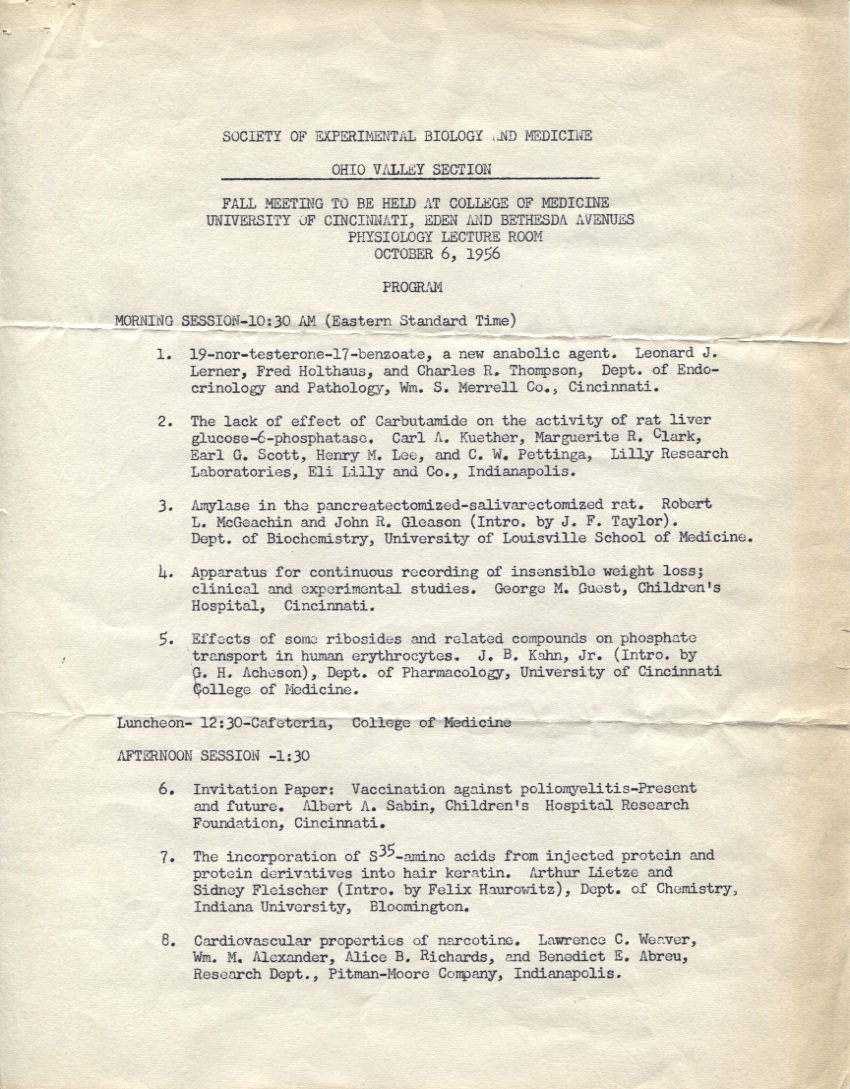A recent Wired.com blog post highlighted an important day in the development of the oral polio vaccine: October 6, 1956. On this date, Dr. Sabin gave an invited paper at the Society of Experimental Biology and Medicine meeting held in Cincinnati. His paper was called “Vaccination against Poliomyelitis – Present and Future.” It was at this meeting that Dr. Sabin reported that he had developed a polio vaccine using three attenuated poliovirus strains, which provided an “immunizing, symptomless infection” when it was administered orally to over 50 volunteers. He also announced that his live-virus polio vaccine was ready to be tested on “increasingly larger numbers of humans both in this country and in association with qualified investigators abroad.”[1]
In the days following this meeting, several newspapers covered the contents of his paper, with headlines such as:
- “Live Polio Vaccine Found – Cinti’s Dr. Sabin Develops Oral Serum,” Cincinnati Times-Star 10/6/1956
- “One-Dose Oral Vaccine Against Polio Revealed,” The Washington Post and Times Herald 10/7/1956
- “Live Vaccine Promises Lifetime Polio Immunity,” The Sunday Star (Washington D.C.) 10/7/1956
- “New, Take-by-Mouth Polio Vaccine Found,” The Miami Herald 10/7/1956
Shortly after the meeting, Dr. Sabin was contacted by the Science Editor of the New York Times, Mr. Waldemar Kaempffert, who wanted more information about his work with the live attenuated vaccine. In his response, Dr. Sabin wrote, “I am deeply chagrined that the newspaper reports which came out after the presentation of my paper to the Ohio Valley Section of the Society for Experimental Biology and Medicine were not quite in accord with the facts. What was not stressed was that the work is still very much in the experimental stage and that although we now have strains of virus which lend themselves for testing on large numbers of people no such mass tests are now visualized[…]” He ended the letter to the editor by saying, “I am highly gratified by your interest and I hope that if you do write anything you may counteract the erroneous impression created over the last week-end and convey the actual state of affairs regarding the experimental status of this work as I expressed it to you here.”
A few days later, Mr. Kaempffert wrote back, “Your letter of October 10 came on Friday morning – in the nick of time.” He mentioned to Dr. Sabin that he read the information very carefully and edited his upcoming article with Dr. Sabin’s letter in mind. This article “New Anti-Polio Vaccine to Be Swallowed Is Ready for Testing on a Large Dramatic Success Study of Eskimos Vaccine’s Function,” appeared in the New York Times on October 14, 1956.[2]
At another meeting, which also occurred in October of that year, Dr. Sabin reported on the “present status” of his vaccine. This report was published in the Journal of the American Medical Association and the Bulletin of the New York Academy of Medicine. Dr. Sabin was on his way to the large-scale testing of his vaccine in 1959.
[1]You can read an article on the meeting that Dr. Sabin reviewed for accuracy in Medical News (October 22, 1956, pages 1 & 3).
[2]The letters to and from Mr. Kaempffert can be found in Series #7 – Oral Polio Vaccine, Box #4 – Correspondence, Miscellaneous, Folder #2 – Announcement, Articles and Letters, 1956-1957.
In 2010, the University of Cincinnati Libraries received a $314,258 grant from the National Endowment for the Humanities (NEH) to digitize the correspondence and photographs of Dr. Albert B. Sabin. This digitization project has been designated a NEH “We the People” project, an initiative to encourage and strengthen the teaching, study, and understanding of American history and culture through the support of projects that explore significant events and themes in our nation’s history and culture and that advance knowledge of the principles that define America. Any views, findings, conclusions, or recommendations expressed in this blog do not necessarily reflect those of the National Endowment for the Humanities.

